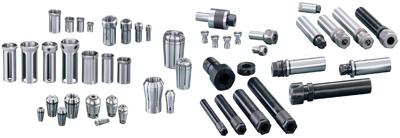
When it comes to tool holding, value is all about precision and reliability that will transmit to the finished part. Hardinge says its toolholder collets, bushings and tool holders are designed and engineered for quality and durability. Hardinge's standard of performance is high to help you achieve the level of accuracy required. Hardinge tool holders and toolholder collets are available in ER, DA (double angle), TG (tremendous grip), HDO, and HF styles. Hardinge also offers standard collets and tool holders in Cincinnati Monoset and 1C styles.
All standard ER-style toolholder collets are manufactured from special alloy steels. They are precision-machined to extremely close tolerances to assure superior concentricity. Hardinge offers a variety of tool holders for ER-style collets that are used to grip drills, taps, reamers, end mills, boring bars, and round shank end working tools. The ER-style single-angle collets are used on Swiss-type lathes and in tool holders for mills and CNC lathes. The DA-style double-angle collet is noted for its parallel gripping capability due to the two angles and opposed split configuration. This places the parallel bearing on the tool shank, as well as the full diameter of the tool.
Cincinnati Monoset toolholder collets are machined toexacting tolerances to guarantee concentricity between the OD of the collet and its bore. Hardinge offers the Cincinnati Monoset collets in the 1CH and the 3CH sizes. The 1C collet, used in Hardinge T17 5⁄8" and ¾" tool holders, is mounted in round tool holders and turrets to place the tool on the spindle centerline for precision drilling. 1C collets provide an accurate method ofholding drills, center drills, round shank boring bars, and round shank turning tools. The 1C eccentric tool holder provides additional adjustment required for most gang tool style top plates. Hardinge 1C collets are available in round, hex, square and decimal sizes.
Hardinge also offers precision-machined HD-style bushings in three styles. The hardness and resiliency manufactured into Hardinge bushings make them the longest lasting and most accurate bushings in the industry. The HDB bushing has a knurled shoulder for easy installation and removal. A flat is milled on the OD of the bushing where the tool holder or the turret set screws clamp on the bushing for maximum surface contact. The HDC bushings feature one or two longitudinal slots, depending on the size of the bore. The slots allow the setscrew from the tool holder to locate directly on the body of the tool. The HDZ bushings also feature either one or two longitudinal slots, depending on the size of the bore. The bushings have a flange with two setscrews 90 degress apart to preset tools prior to installing them into the machine tool.
Contact Details
Related Glossary Terms
- alloy steels
alloy steels
Steel containing specified quantities of alloying elements (other than carbon and the commonly accepted amounts of manganese, sulfur and phosphorus) added to cause changes in the metal’s mechanical and/or physical properties. Principal alloying elements are nickel, chromium, molybdenum and silicon. Some grades of alloy steels contain one or more of these elements: vanadium, boron, lead and copper.
- boring
boring
Enlarging a hole that already has been drilled or cored. Generally, it is an operation of truing the previously drilled hole with a single-point, lathe-type tool. Boring is essentially internal turning, in that usually a single-point cutting tool forms the internal shape. Some tools are available with two cutting edges to balance cutting forces.
- bushing
bushing
Cylindrical sleeve, typically made from high-grade tool steel, inserted into a jig fixture to guide cutting tools. There are three main types: renewable, used in liners that in turn are installed in the jig; press-fit, installed directly in the jig for short production runs; and liner (or master), installed permanently in a jig to receive renewable bushing.
- collet
collet
Flexible-sided device that secures a tool or workpiece. Similar in function to a chuck, but can accommodate only a narrow size range. Typically provides greater gripping force and precision than a chuck. See chuck.
- computer numerical control ( CNC)
computer numerical control ( CNC)
Microprocessor-based controller dedicated to a machine tool that permits the creation or modification of parts. Programmed numerical control activates the machine’s servos and spindle drives and controls the various machining operations. See DNC, direct numerical control; NC, numerical control.
- flat ( screw flat)
flat ( screw flat)
Flat surface machined into the shank of a cutting tool for enhanced holding of the tool.
- hardness
hardness
Hardness is a measure of the resistance of a material to surface indentation or abrasion. There is no absolute scale for hardness. In order to express hardness quantitatively, each type of test has its own scale, which defines hardness. Indentation hardness obtained through static methods is measured by Brinell, Rockwell, Vickers and Knoop tests. Hardness without indentation is measured by a dynamic method, known as the Scleroscope test.
- outer diameter ( OD)
outer diameter ( OD)
Dimension that defines the exterior diameter of a cylindrical or round part. See ID, inner diameter.
- parallel
parallel
Strip or block of precision-ground stock used to elevate a workpiece, while keeping it parallel to the worktable, to prevent cutter/table contact.
- shank
shank
Main body of a tool; the portion of a drill or similar end-held tool that fits into a collet, chuck or similar mounting device.
- toolholder
toolholder
Secures a cutting tool during a machining operation. Basic types include block, cartridge, chuck, collet, fixed, modular, quick-change and rotating.
- turning
turning
Workpiece is held in a chuck, mounted on a face plate or secured between centers and rotated while a cutting tool, normally a single-point tool, is fed into it along its periphery or across its end or face. Takes the form of straight turning (cutting along the periphery of the workpiece); taper turning (creating a taper); step turning (turning different-size diameters on the same work); chamfering (beveling an edge or shoulder); facing (cutting on an end); turning threads (usually external but can be internal); roughing (high-volume metal removal); and finishing (final light cuts). Performed on lathes, turning centers, chucking machines, automatic screw machines and similar machines.

